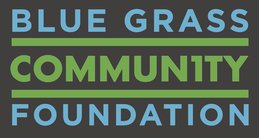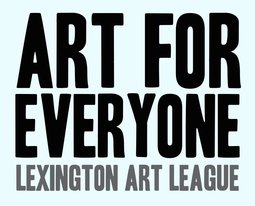Castlewood Downs
Castlewood Downs Inaugural Year Artists Include:
Carl Billingsley, Isaac Duncan, Walter Early, Jim Galluci, Adam Garey, John Henry, Ray Katz, Gary Kulak, Bret Price, Bryce Robinson
Carl Billingsley, Isaac Duncan, Walter Early, Jim Galluci, Adam Garey, John Henry, Ray Katz, Gary Kulak, Bret Price, Bryce Robinson
| castlewood_downs_info_document.pdf | |
| File Size: | 24885 kb |
| File Type: | |
|
A Model Public Art Program for Lexington Kentucky in Partnership with Parks and Recreation
|
Castlewood Downs is made possible by
Bluegrass Community Foundation, LexArts, VisitLex, Mason Structure, L. Tracee Whitley, Jeff & Lora Carter, Arthur Schechet & Marilyn Robie, Jomo Thompson, Dr. David & Beverly Hufford, Marco Logsdon & Michael Satterly, Jan & Larry Isenhour, Graham Pohl & Jane Fields, Pohl Rosa Pohl, Griffin & Sarah Wylie VanMeter, Haviland Argo, Richard Greissman, Cooper Stofer & LAVA Systems, Bristol Group, Poage Engineers & Associates |
Initiative: The Lexington Art League understands that art is a powerful connector of diverse people and ideas. Castlewood Downs, aims to create a space for that connection to occur within the 30 acres surrounding the Loudoun House, located in Castlewood Park. Inclusion, accessibility and diversity are woven into the mission of LAL, which has served as a catalyst for creative place making for the North Lexington community for decades.
LAL is situated at the cross section of two historic neighborhoods, Castlewood and North Limestone. In addition to LALs curatorial, artist centered, and outreach programs, the Loudoun House gallery serves as a cultural hub for the community. Neighborhood meetings, tours, family days, weddings and other community focused activities enliven LAL’s headquarters.
LAL is committed to inclusion and diversity through its programmatic efforts. In the spirit of that commitment and to authentically engage their community, LAL has designed year round after school art programs, interactive family and group tours, and summer camp programs that are accessible and inclusive. These programs have been designed in support of their Art For Everyone Initiative
Historic Context : Outdoor sculpture or “public art” is distinguished by its accessibility and location within or apart of everyday spaces. This rejection of the museum/gallery institution challenges the separation between art and lived experience. Often monumental in size, public art can be traced back to ancient civilizations where civic monuments were created to beautify city centers, express political messages or generate civic pride.
During the late 1960’s and early 70’s, environmental and land artists including Robert Smithson, Nancy Holt and Andy Goldsworthy began making works that utilized both natural spaces and materials, merging art and landscape. Contemporary iterations of public art, such as those included in Castlewood Downs, continue in a similar vein by seeking to incorporate art in the real world and vice versa.
LAL is situated at the cross section of two historic neighborhoods, Castlewood and North Limestone. In addition to LALs curatorial, artist centered, and outreach programs, the Loudoun House gallery serves as a cultural hub for the community. Neighborhood meetings, tours, family days, weddings and other community focused activities enliven LAL’s headquarters.
LAL is committed to inclusion and diversity through its programmatic efforts. In the spirit of that commitment and to authentically engage their community, LAL has designed year round after school art programs, interactive family and group tours, and summer camp programs that are accessible and inclusive. These programs have been designed in support of their Art For Everyone Initiative
Historic Context : Outdoor sculpture or “public art” is distinguished by its accessibility and location within or apart of everyday spaces. This rejection of the museum/gallery institution challenges the separation between art and lived experience. Often monumental in size, public art can be traced back to ancient civilizations where civic monuments were created to beautify city centers, express political messages or generate civic pride.
During the late 1960’s and early 70’s, environmental and land artists including Robert Smithson, Nancy Holt and Andy Goldsworthy began making works that utilized both natural spaces and materials, merging art and landscape. Contemporary iterations of public art, such as those included in Castlewood Downs, continue in a similar vein by seeking to incorporate art in the real world and vice versa.
Featured Artists
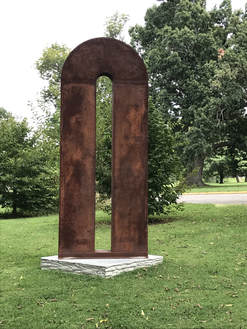
Carl Billingsley - Narrow Passage, oiled steel, NFS
Artwork Statement: “Narrow Passage” is an abstract sculpture that takes the form of an architectural structure. "..Passage" is very simply a free standing gate or entryway with a hemispherical ‘Roman Arch.’ What makes it a sculpture and NOT a piece of architecture is primarily the fact that it has no other architectural attributes, it is not part of a wall, building or other contexts. It stands alone and can just as easily be walked around , past or ignored ,as pasted through. However, the familiarity of the form draws people to it and even compels some to attempt to go through the very narrow space defined by the sculpture. Metaphorically, "Narrow Passage" poses the question of how we define terms such as Architecture and Sculpture, what we mean when we create these parts of our built environment and how those meanings develop and change over time and in different contexts. '..Passage' also references the psychological , social and emotional aspects of Architecture and Sculpture. What narrow passages have you encountered in your life?
Artist Statement: For me sculpture is a special means of communication. It is a way for me to express some of my thoughts and ideas about the human condition. I usually create abstract sculptures that don’t represent objects, persons or creatures. More likely, the sculptures are about human activities and ideas that have preoccupied our species for millennia. Ideas such as way-finding, discovery of the materials and processes that have enabled us to build modern civilization and how those activities and materials are still in use today. I often reference history, technical processes and I always try to show something about how the sculpture was created. In a casting, for instance, I will often leave mold lines visible so that the viewers can understand that the sculpture was cast. When I carve stone or wood I leave tool marks. I am inspired by my connection as an artist to all artists that have gone before me and all those who will follow. We are part of a great continuum of human history.
Artwork Statement: “Narrow Passage” is an abstract sculpture that takes the form of an architectural structure. "..Passage" is very simply a free standing gate or entryway with a hemispherical ‘Roman Arch.’ What makes it a sculpture and NOT a piece of architecture is primarily the fact that it has no other architectural attributes, it is not part of a wall, building or other contexts. It stands alone and can just as easily be walked around , past or ignored ,as pasted through. However, the familiarity of the form draws people to it and even compels some to attempt to go through the very narrow space defined by the sculpture. Metaphorically, "Narrow Passage" poses the question of how we define terms such as Architecture and Sculpture, what we mean when we create these parts of our built environment and how those meanings develop and change over time and in different contexts. '..Passage' also references the psychological , social and emotional aspects of Architecture and Sculpture. What narrow passages have you encountered in your life?
Artist Statement: For me sculpture is a special means of communication. It is a way for me to express some of my thoughts and ideas about the human condition. I usually create abstract sculptures that don’t represent objects, persons or creatures. More likely, the sculptures are about human activities and ideas that have preoccupied our species for millennia. Ideas such as way-finding, discovery of the materials and processes that have enabled us to build modern civilization and how those activities and materials are still in use today. I often reference history, technical processes and I always try to show something about how the sculpture was created. In a casting, for instance, I will often leave mold lines visible so that the viewers can understand that the sculpture was cast. When I carve stone or wood I leave tool marks. I am inspired by my connection as an artist to all artists that have gone before me and all those who will follow. We are part of a great continuum of human history.

Jim Collins - Cowboy Watcher, 2016, Stainless Steel and Powder Coated Steel, $7,500
Artwork Statement: The WATCHER SERIES started in 1978 I began with two figures in half-inch thick mild steel. The peaceful figure of the seated man has progressed to approximately 100 individual sculptures and can be found in both public and private collections from Maine to Florida with the majority located in the Southeastern United States. Plus, in 2004 the Watcher Family went international with the Black and Amber Watcher perched at Langton’s Pub in Kilkenny Ireland and two Watchers are setting at the County Council Building in Limerick Ireland.
Artist Bio: Jim Collins is a Public Art sculptor working in a figurative manner, best exemplified by his long running series the WATCHER. He works in both Chattanooga (TN) and Highlands (NC). Collins holds an M.F.A. in sculpture from Ohio University and was a Professor of Fine Art at the University of Tennessee-Chattanooga. The monograph Jim Collins: Art, 1963-2003, was published by Two Hands Art Publishing. His work is in public collections including the Tennessee State Museum, Nashville, TN; Huntington (WV) Museum of Art; Milwaukee (WI) Art Center; and completed three Public Sculpture Commissions in Ireland. He is listed in Who’s Who in American Art.
Artwork Statement: The WATCHER SERIES started in 1978 I began with two figures in half-inch thick mild steel. The peaceful figure of the seated man has progressed to approximately 100 individual sculptures and can be found in both public and private collections from Maine to Florida with the majority located in the Southeastern United States. Plus, in 2004 the Watcher Family went international with the Black and Amber Watcher perched at Langton’s Pub in Kilkenny Ireland and two Watchers are setting at the County Council Building in Limerick Ireland.
Artist Bio: Jim Collins is a Public Art sculptor working in a figurative manner, best exemplified by his long running series the WATCHER. He works in both Chattanooga (TN) and Highlands (NC). Collins holds an M.F.A. in sculpture from Ohio University and was a Professor of Fine Art at the University of Tennessee-Chattanooga. The monograph Jim Collins: Art, 1963-2003, was published by Two Hands Art Publishing. His work is in public collections including the Tennessee State Museum, Nashville, TN; Huntington (WV) Museum of Art; Milwaukee (WI) Art Center; and completed three Public Sculpture Commissions in Ireland. He is listed in Who’s Who in American Art.
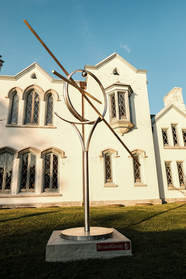
Isaac Duncan II - Khaleesi-Pa
Artist Statement: I have always created forms that speak of the phenomenological perspective of understanding through the acceptance of “that, which is.” It is through our individual physical experiences that we understand our environment and “that which is.” I believe that my works galvanize people to investigate and assess that which is in front of them and it's relationship to them. By doing this, they recognize that there is something present and that it's presence is essentially the byproduct of the celebration of humanity. With the acceptance that an inanimate object, which looks nothing like one is accustom to, one opens up to the acceptance that “that which is” different is also a celebration of life. And in celebrating life, one agrees that “that” which is different is like oneself. In these days and times, humanity really needs to understand this.
The notion that art is an expression of life is the foundation that I sculpt on. I am constantly creating works of art that give the feeling of motion: hence the sphere, angles, balanced and unbalanced elements, and voids. The elements of the sphere, curved forms and grinding patterns emphasize motion and motion implies life. Not only do I use various elements in my composition to imply life, but I also compose my initial thoughts while sculpting a piece in the same manner. By sculpting in the “direct method,” I do not sketch or create drawings for my sculpture. I am always creating in the round; from thought to actuality. I am always in the present and continuously making immediate decisions that lead me to the next set of circumstances, as in life.
Artist Statement: I have always created forms that speak of the phenomenological perspective of understanding through the acceptance of “that, which is.” It is through our individual physical experiences that we understand our environment and “that which is.” I believe that my works galvanize people to investigate and assess that which is in front of them and it's relationship to them. By doing this, they recognize that there is something present and that it's presence is essentially the byproduct of the celebration of humanity. With the acceptance that an inanimate object, which looks nothing like one is accustom to, one opens up to the acceptance that “that which is” different is also a celebration of life. And in celebrating life, one agrees that “that” which is different is like oneself. In these days and times, humanity really needs to understand this.
The notion that art is an expression of life is the foundation that I sculpt on. I am constantly creating works of art that give the feeling of motion: hence the sphere, angles, balanced and unbalanced elements, and voids. The elements of the sphere, curved forms and grinding patterns emphasize motion and motion implies life. Not only do I use various elements in my composition to imply life, but I also compose my initial thoughts while sculpting a piece in the same manner. By sculpting in the “direct method,” I do not sketch or create drawings for my sculpture. I am always creating in the round; from thought to actuality. I am always in the present and continuously making immediate decisions that lead me to the next set of circumstances, as in life.
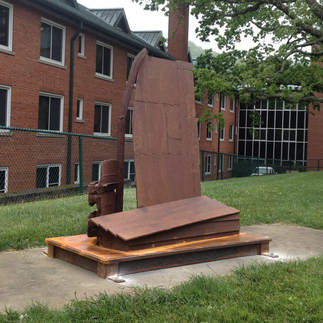
Walter Early - The Gate Hangs Well, 2016, welded steel, 5.5 x 6.5 x 3.5 feet, view of work installed on the campus of Appalachian State University, North Carolina
Artwork Statement: The Gate Hangs Well was created during an artist residency at the Museum of Steel Sculpture in Coalbrookdale, England where it remained on display until recently. This residency was sponsored by grants from the Henry Moore Foundation and the Nanovic Institute for European Studies. I went to research and respond to abstract sculpture created in the late 60s/early 70s, but became very influenced by the abandoned churches and abbeys that dotted the surrounding landscape. This piece is from a series of works in a cubist fashion and deconstructs (or unfolds) views of those architectural relics. Each piece in the series was titled after pubs in the area as a nod to a William Blake poem remarking on the similarities of the two institutions' clientele.
Artist Statement: My creative work is series-based and explores object valuation systems. Similar to still life painting and photography, found objects are often utilized or referenced as a metaphor for life cycles. Formally the work draws from the language of fragments; using incomplete forms to allude to a larger whole. The sculptures included in this proposal began as planar, volumetric constructions made in steel by artists other than myself. I displace them from their original context by removing most of the visual information, distilling the forms down to moments in which the original artist made decisions concerning the sculpture’s limits: the welded contours. Recently I have begun to further monumentalize these gestures by treating the pieces as maquettes for large scale, outdoor work. Bright monochrome pigment plays with perceptions of mass, weight, and volume.
Artist Bio: Walter Early is a Chicago-based sculpture artists who also works in film, painting and prints. Often composing and construction en plein air, the objects Walter creates emphasize the role of human presence in the natural world. Walther obtained his MFA fro the University of Notre Dame. His recent works have been exhibited at the Giles Gallery and ArtsPlace in Kentucky, the Marquette and Culture Center of Michigan, and Water Street Studios in Illinois. Walter has been a resident artist in the Ironbridge Open Air Museum of Steel Sculpture in Coalbrookdale, UK and that the Blueberry View Artist Residency in Benton Harbor, Michigan.
Artwork Statement: The Gate Hangs Well was created during an artist residency at the Museum of Steel Sculpture in Coalbrookdale, England where it remained on display until recently. This residency was sponsored by grants from the Henry Moore Foundation and the Nanovic Institute for European Studies. I went to research and respond to abstract sculpture created in the late 60s/early 70s, but became very influenced by the abandoned churches and abbeys that dotted the surrounding landscape. This piece is from a series of works in a cubist fashion and deconstructs (or unfolds) views of those architectural relics. Each piece in the series was titled after pubs in the area as a nod to a William Blake poem remarking on the similarities of the two institutions' clientele.
Artist Statement: My creative work is series-based and explores object valuation systems. Similar to still life painting and photography, found objects are often utilized or referenced as a metaphor for life cycles. Formally the work draws from the language of fragments; using incomplete forms to allude to a larger whole. The sculptures included in this proposal began as planar, volumetric constructions made in steel by artists other than myself. I displace them from their original context by removing most of the visual information, distilling the forms down to moments in which the original artist made decisions concerning the sculpture’s limits: the welded contours. Recently I have begun to further monumentalize these gestures by treating the pieces as maquettes for large scale, outdoor work. Bright monochrome pigment plays with perceptions of mass, weight, and volume.
Artist Bio: Walter Early is a Chicago-based sculpture artists who also works in film, painting and prints. Often composing and construction en plein air, the objects Walter creates emphasize the role of human presence in the natural world. Walther obtained his MFA fro the University of Notre Dame. His recent works have been exhibited at the Giles Gallery and ArtsPlace in Kentucky, the Marquette and Culture Center of Michigan, and Water Street Studios in Illinois. Walter has been a resident artist in the Ironbridge Open Air Museum of Steel Sculpture in Coalbrookdale, UK and that the Blueberry View Artist Residency in Benton Harbor, Michigan.

Jim Galluci -Tumble Gate, 2011, galvanized steel, $13,000
Artwork Statement: Open gateway evoking blocks tumbling to the ground – symbolic of our open gateways that are starting to crumble and close”
Artist Statement: I strive to create works that are accessible to the public, that inspires them and hopefully makes them aware of the positive impact art can have in everyday life.
Art is a physical manifestation of an idea or event that calls forth an emotional response from the viewer. It speaks to us and evokes a chord deep within us. Good art challenges us, can make us feel righteous, moves us, soothes us and can bring us peace.
Artist Bio: Jim Gallucci has been a sculptor for 40 years and works full time designing and creating/fabricating sculptures in his Greensboro studio assisted by a staff of 8 people. His commissions can be found in public, corporate, and residential spaces throughout the country. Jim is currently showing his work in over 30 sculpture shows across the county.
Artwork Statement: Open gateway evoking blocks tumbling to the ground – symbolic of our open gateways that are starting to crumble and close”
Artist Statement: I strive to create works that are accessible to the public, that inspires them and hopefully makes them aware of the positive impact art can have in everyday life.
Art is a physical manifestation of an idea or event that calls forth an emotional response from the viewer. It speaks to us and evokes a chord deep within us. Good art challenges us, can make us feel righteous, moves us, soothes us and can bring us peace.
Artist Bio: Jim Gallucci has been a sculptor for 40 years and works full time designing and creating/fabricating sculptures in his Greensboro studio assisted by a staff of 8 people. His commissions can be found in public, corporate, and residential spaces throughout the country. Jim is currently showing his work in over 30 sculpture shows across the county.
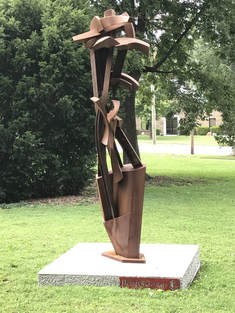
Adam Garey - Phoenix, 2017, Fabricated Steel, $14,000
Artist Statement: From a young age, a strong work ethic was instilled in me. Not from chastisement or reward, but from a compelling example of knowing what should be done and doing it, whatever the cost.
When thinking about my artwork and a unifying statement that transmits throughout, I came to the conclusion that the more words I used, the less I actually said. My drive is not to write but to communicate visually in three dimensions. However, during my search for words, one appeared over and over: WORK. This small four-letter word expresses a great deal about my sculpture and my process. This world and I have a great deal in common.
Artist Statement: From a young age, a strong work ethic was instilled in me. Not from chastisement or reward, but from a compelling example of knowing what should be done and doing it, whatever the cost.
When thinking about my artwork and a unifying statement that transmits throughout, I came to the conclusion that the more words I used, the less I actually said. My drive is not to write but to communicate visually in three dimensions. However, during my search for words, one appeared over and over: WORK. This small four-letter word expresses a great deal about my sculpture and my process. This world and I have a great deal in common.
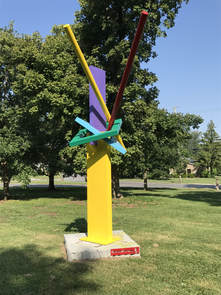
Ray Katz - Red Green Construction on Painted Steel
Artist Statement: I combine colored geometric and organic elements to create compositions that convey the kinetic energy implied in my work. I use the abstract manipulation of form and shape in space to create visual balance, using rhythm, action and movement. The implied energy of my compositional structures has become a hallmark of my work and is a metaphor for an evolutionary process that I associate with human experience. Through the creative -process a hierarchy of elements become symbols for ideas that are a tribute to the transcendental experience we all share in common, and in the transcendent experiences inherent in life’s journey.
I have worked in many mediums but metal is my passion. Metal is best suited for my work because of its strength, malleability and inherent beauty. I combine geometric and organic elements to create compositions that convey the kinetic energy implied in my work. I use the abstract manipulation of form and shape in space to create visual balance, using rhythm, action and movement. The implied energy of my compositional structures has become a hallmark of my work and is a metaphor for an evolutionary process that I associate with human experience. Through the creative -process a hierarchy of elements become symbols for ideas that are a tribute to the transcendental experience we all share in common, and in the transcendent experiences inherent in life’s journey.”
Artist Bio: Ray Katz was born and raised in Detroit Michigan where he attended Mumford High School. Immediately after high school he served four years in the United States Air Force where he became interested in art. Upon returning from the military he attended Detroit Society of Arts and Crafts and Eastern Michigan University where he received his Bachelor of Science in Fine Arts. He continued his education at Wayne State University where he received his Master of Fine Arts degree in sculpture and drawing. Currently he is a Professor of Art at the Auburn Hills, Michigan, campus of Oakland Community College where he teaches sculpture, drawing and design.
Artist Statement: I combine colored geometric and organic elements to create compositions that convey the kinetic energy implied in my work. I use the abstract manipulation of form and shape in space to create visual balance, using rhythm, action and movement. The implied energy of my compositional structures has become a hallmark of my work and is a metaphor for an evolutionary process that I associate with human experience. Through the creative -process a hierarchy of elements become symbols for ideas that are a tribute to the transcendental experience we all share in common, and in the transcendent experiences inherent in life’s journey.
I have worked in many mediums but metal is my passion. Metal is best suited for my work because of its strength, malleability and inherent beauty. I combine geometric and organic elements to create compositions that convey the kinetic energy implied in my work. I use the abstract manipulation of form and shape in space to create visual balance, using rhythm, action and movement. The implied energy of my compositional structures has become a hallmark of my work and is a metaphor for an evolutionary process that I associate with human experience. Through the creative -process a hierarchy of elements become symbols for ideas that are a tribute to the transcendental experience we all share in common, and in the transcendent experiences inherent in life’s journey.”
Artist Bio: Ray Katz was born and raised in Detroit Michigan where he attended Mumford High School. Immediately after high school he served four years in the United States Air Force where he became interested in art. Upon returning from the military he attended Detroit Society of Arts and Crafts and Eastern Michigan University where he received his Bachelor of Science in Fine Arts. He continued his education at Wayne State University where he received his Master of Fine Arts degree in sculpture and drawing. Currently he is a Professor of Art at the Auburn Hills, Michigan, campus of Oakland Community College where he teaches sculpture, drawing and design.
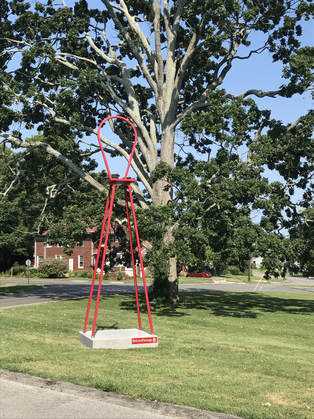
Gary Kulak - Green Windswept, 2015, Powder Coated Steel 18’ x 4’ x 4’ $17,500
Artist Statement: Creating presence through absence using a chair to represent the “human spirit” is the center of a 40-year life investigation. Embracing cultural differences, socio- economic constructs, and psychological perspectives through use of the common historical object, the chair, gives the viewer a frame of reference, an identity, and a basis for communication. Construction materials of the work are primarily welded steel using industrial processes. The goal of this work is to create bridges, to signify relationships between individual and community, private and public, cultural and natural, and to use the metaphor of figure, the chair, to exemplify the human spirit.
Living in a world changing at an ever increasing rate of speed allows for greater clarity. World event images in real time are uncensored and raw. This collected data gets organized into new thoughts, forms, and ideas. The impressions of these images, not the actual representations, are the source of ideas. This work’s representation of a chair is a line drawing in space. What one sees is as important as what one does not see.
Allowing the observer to complete the question of meaning on their own, creates an active approach to participation. Intellectual participation occurs as a direct result of the observation. This reconnects to the chair’s meaning being specific to each individual’s experiences and history, leading them to embrace their own cultural differences and socio-economic constructs.
Artist Bio: As the son of a steelworker and grandson of a coal miner, Gary Kulak grew up in Noblestown, Pennsylvania, a small town outside Pittsburgh. He remembers visiting Bethlehem Steel Co. with his father and the discussions of the mill at dinner. In Pittsburgh, everyone spoke of the mills and legend has it that the iron in the water made them strong. Gary’s father made sure he pursued an education and did not have life in the mills. As an artist, Mr. Kulak continues a tradition of drawing from the memories of his youth and embedding them in steel. Gary began his career as a professional sculptor in 1974 graduating with a BFA from Cranbrook in 1975. He completed his MFA from Hunter College in 1983. At Cranbrook, he studied with Michael Hall.
Upon graduation, as an independent artist, Gary assisted Sol Lewitt, John Mason and Lyman Kipp with installations of their work. At Hunter College in New York, Gary studied with John Mason, Robert Morris and was Alice Aycock’s studio assistant. Gary’s work is a part of many public and private collections throughout the US. He is currently Head, Fine Arts Department at Cranbrook Schools in Bloomfield Hills, Michigan.
Artist Statement: Creating presence through absence using a chair to represent the “human spirit” is the center of a 40-year life investigation. Embracing cultural differences, socio- economic constructs, and psychological perspectives through use of the common historical object, the chair, gives the viewer a frame of reference, an identity, and a basis for communication. Construction materials of the work are primarily welded steel using industrial processes. The goal of this work is to create bridges, to signify relationships between individual and community, private and public, cultural and natural, and to use the metaphor of figure, the chair, to exemplify the human spirit.
Living in a world changing at an ever increasing rate of speed allows for greater clarity. World event images in real time are uncensored and raw. This collected data gets organized into new thoughts, forms, and ideas. The impressions of these images, not the actual representations, are the source of ideas. This work’s representation of a chair is a line drawing in space. What one sees is as important as what one does not see.
Allowing the observer to complete the question of meaning on their own, creates an active approach to participation. Intellectual participation occurs as a direct result of the observation. This reconnects to the chair’s meaning being specific to each individual’s experiences and history, leading them to embrace their own cultural differences and socio-economic constructs.
Artist Bio: As the son of a steelworker and grandson of a coal miner, Gary Kulak grew up in Noblestown, Pennsylvania, a small town outside Pittsburgh. He remembers visiting Bethlehem Steel Co. with his father and the discussions of the mill at dinner. In Pittsburgh, everyone spoke of the mills and legend has it that the iron in the water made them strong. Gary’s father made sure he pursued an education and did not have life in the mills. As an artist, Mr. Kulak continues a tradition of drawing from the memories of his youth and embedding them in steel. Gary began his career as a professional sculptor in 1974 graduating with a BFA from Cranbrook in 1975. He completed his MFA from Hunter College in 1983. At Cranbrook, he studied with Michael Hall.
Upon graduation, as an independent artist, Gary assisted Sol Lewitt, John Mason and Lyman Kipp with installations of their work. At Hunter College in New York, Gary studied with John Mason, Robert Morris and was Alice Aycock’s studio assistant. Gary’s work is a part of many public and private collections throughout the US. He is currently Head, Fine Arts Department at Cranbrook Schools in Bloomfield Hills, Michigan.

Bret Price - Vertigo, 2014, 10.5 ft. h., Steel, $85,000
Artist Statement: Since 1979, I have been building heating chambers around large pieces of steel, applying concentrated, intense heat, then manipulating the material to create a sense of softness. When the heat is removed, these illusions of flexibility are frozen, and on one level, the sculpture becomes a documentation of those forces used in the process. It is my intent that these sculptures communicate a sense of continuance, as if each piece is a single frame taken from a film, appearing to be at rest before moving on.o
This method of making art offers a number of creative options for me as a sculptor. The variables of heat intensity, size and shape of the raw material produce a wide range of results; from the quiet simplicity of a single pipe bend to the rhythmic complexity that emerges from folding a section of structural steel. A degree of unpredictability is always present, which tends to tease one’s curiosity and lend energy.
Artist Statement: Since 1979, I have been building heating chambers around large pieces of steel, applying concentrated, intense heat, then manipulating the material to create a sense of softness. When the heat is removed, these illusions of flexibility are frozen, and on one level, the sculpture becomes a documentation of those forces used in the process. It is my intent that these sculptures communicate a sense of continuance, as if each piece is a single frame taken from a film, appearing to be at rest before moving on.o
This method of making art offers a number of creative options for me as a sculptor. The variables of heat intensity, size and shape of the raw material produce a wide range of results; from the quiet simplicity of a single pipe bend to the rhythmic complexity that emerges from folding a section of structural steel. A degree of unpredictability is always present, which tends to tease one’s curiosity and lend energy.
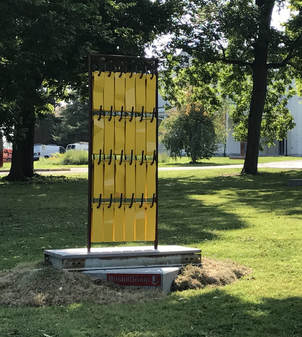

John Henry is known worldwide for his large-scale public works of art. His works grace numerous important museum, corporate, public and private collections as well as the collections of many American cities and states. His works are also prominently exhibited in the public collections of various European and Asian municipalities.
Mr. Henry has shown his work extensively since the early 1960’s and exhibits a definitive trademark style that is recognized internationally. His works range in scale from small tabletop pieces to some of the largest contemporary metal sculptures in the world. His recent exhibitions of works include “New Monuments” at the Laumeier Sculpture Park in St. Louis, Missouri, “Back on the Plaza” on Chicago’s Magnificent Mile, “Real-Irreal-Surreal”, at Art- St-Urban in St. Urban, Switzerland, “OPEN” in Venice, Italy, and “ODYSSEY” at Purdue North Central University in Westville, Indiana. Currently, he is also a featured artist in the Vancouver Biennale in British Columbia.
Mr. Henry attended the University of Kentucky, University of Chicago and the Art Institute of Chicago, where he received a Ford Foundation grant, the Edward L Ryerson Fellowship and earned a BFA. He received an Honorary Doctor of Arts from the University of Kentucky in 1996. As a visiting professor of sculpture, Mr. Henry taught at University of lowa, University of Wisconsin, University of Chicago and the School of the Art Institute of Chicago. He is currently Distinguished Professor of Art at Chattanooga State College. In 2002 he received the Governor’s National Award in the Arts from the State of Kentucky and in 2004, the Mayor’s Award of Distinction in the Arts from the City of Chattanooga. Other recent honor’s include recognition on the floor of the Tennessee State Senate in 2004 and the 2005 honorary renaming of North Cermak Road “John Henry Way” by the City of Chicago in recognition of his contributions to Public Art on the local and national levels.
As an active participant in promoting the arts Mr. Henry has served as a member of the Advisory Board of Lawyers for the Creative Arts in Chicago, a coordinator and advisor to the City and the Art Institute of Chicago for the "Sculpture in the Parks Exhibition" and as an advisor to the Art Council of Greater New Orleans for the "Super Sculpture New Orleans" Exhibition. Since 1991 he has been on the Board of Trustees of the National Foundation for Advancement in the Arts, serving as Board member at large, Chairman of the Programs Committee and member of the Executive committee. Since 1996 he has served the Board of the International Sculpture Center in various leadership roles, serving as Chairman for two years through the spring of 2002. Mr. Henry has lectured extensively on the role of art in public places and is known as a strong advocate of all of the arts, not only sculpture.
Mr. Henry has shown his work extensively since the early 1960’s and exhibits a definitive trademark style that is recognized internationally. His works range in scale from small tabletop pieces to some of the largest contemporary metal sculptures in the world. His recent exhibitions of works include “New Monuments” at the Laumeier Sculpture Park in St. Louis, Missouri, “Back on the Plaza” on Chicago’s Magnificent Mile, “Real-Irreal-Surreal”, at Art- St-Urban in St. Urban, Switzerland, “OPEN” in Venice, Italy, and “ODYSSEY” at Purdue North Central University in Westville, Indiana. Currently, he is also a featured artist in the Vancouver Biennale in British Columbia.
Mr. Henry attended the University of Kentucky, University of Chicago and the Art Institute of Chicago, where he received a Ford Foundation grant, the Edward L Ryerson Fellowship and earned a BFA. He received an Honorary Doctor of Arts from the University of Kentucky in 1996. As a visiting professor of sculpture, Mr. Henry taught at University of lowa, University of Wisconsin, University of Chicago and the School of the Art Institute of Chicago. He is currently Distinguished Professor of Art at Chattanooga State College. In 2002 he received the Governor’s National Award in the Arts from the State of Kentucky and in 2004, the Mayor’s Award of Distinction in the Arts from the City of Chattanooga. Other recent honor’s include recognition on the floor of the Tennessee State Senate in 2004 and the 2005 honorary renaming of North Cermak Road “John Henry Way” by the City of Chicago in recognition of his contributions to Public Art on the local and national levels.
As an active participant in promoting the arts Mr. Henry has served as a member of the Advisory Board of Lawyers for the Creative Arts in Chicago, a coordinator and advisor to the City and the Art Institute of Chicago for the "Sculpture in the Parks Exhibition" and as an advisor to the Art Council of Greater New Orleans for the "Super Sculpture New Orleans" Exhibition. Since 1991 he has been on the Board of Trustees of the National Foundation for Advancement in the Arts, serving as Board member at large, Chairman of the Programs Committee and member of the Executive committee. Since 1996 he has served the Board of the International Sculpture Center in various leadership roles, serving as Chairman for two years through the spring of 2002. Mr. Henry has lectured extensively on the role of art in public places and is known as a strong advocate of all of the arts, not only sculpture.
More about Castlewood Downs
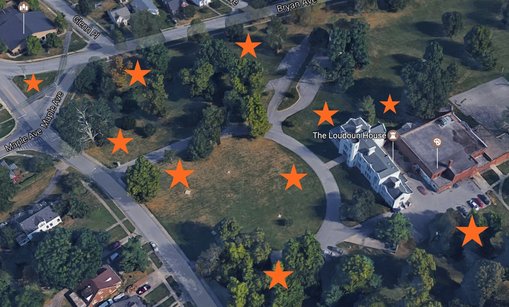 Proposed Sculpture Locations for Castlewood Downs in 2017
Proposed Sculpture Locations for Castlewood Downs in 2017
The Lexington Art League has kicked off its fundraising campaign to support a new public art initiative entitled, Castlewood Downs. This creative place-making project, presented in partnership with LFUCG Parks and Recreations, will create an interactive green space in one of Lexington’s most culturally and economically diverse communities. The program will begin in July 2017 with an exhibition of sculptures originating from a national call to artists. It will be juried by the internationally acclaimed sculptor and Lexington native, John Henry.
“Castlewood Downs is the embodiment of LAL’s Art For Everyone programming philosophy. LAL believes strongly that art should be accessible to all, and that this program will take that concept to a new and exciting level. By placing works of art in the heart of one our city’s most utilized parks, we have a unique opportunity to dissolve the boundaries created by the walls of our gallery in an inclusive and welcoming public art space.” stated Stephanie Harris, Executive Director, Lexington Art League.
Following the jury process, the selected sculptures will be sited in Castlewood Park for two years, with installation taking place July 24-28, 2017. While this program will be activated through an exhibition for its initial installment, LAL and Parks & Recreation envision that this will be the beginning of a model program for the city of Lexington. By utilizing the infrastructure provided by Lexington’s vast parks system, the goal of this program is that it will evolve into a multi-venue public art program that will have a profound impact on the quality of life for members of the Lexington community.
“Lexington Parks and Recreation are dedicated to making the arts available to all citizens and using our parklands for public art is a great way to make that possible. In addition to the numerous arts programs we provide throughout the year at our different facilities, we are happy to help progress new initiatives with our community partners such as the Lexington Art League. This particular project deepens the partnership between the arts community and Parks & Recreation, while celebrating sculpture in one of Lexington’s oldest community parks.” stated Monica Conrad, Director of LFCUG Parks and Recreation.
Donors wishing to persue significant contributes toward this campaign and the Bluegrass Community Foundations 2-1 matching grant up to $20,000 may contact Stephanie Harris, Lexington Art League’s Executive Director at [email protected]
“Castlewood Downs is the embodiment of LAL’s Art For Everyone programming philosophy. LAL believes strongly that art should be accessible to all, and that this program will take that concept to a new and exciting level. By placing works of art in the heart of one our city’s most utilized parks, we have a unique opportunity to dissolve the boundaries created by the walls of our gallery in an inclusive and welcoming public art space.” stated Stephanie Harris, Executive Director, Lexington Art League.
Following the jury process, the selected sculptures will be sited in Castlewood Park for two years, with installation taking place July 24-28, 2017. While this program will be activated through an exhibition for its initial installment, LAL and Parks & Recreation envision that this will be the beginning of a model program for the city of Lexington. By utilizing the infrastructure provided by Lexington’s vast parks system, the goal of this program is that it will evolve into a multi-venue public art program that will have a profound impact on the quality of life for members of the Lexington community.
“Lexington Parks and Recreation are dedicated to making the arts available to all citizens and using our parklands for public art is a great way to make that possible. In addition to the numerous arts programs we provide throughout the year at our different facilities, we are happy to help progress new initiatives with our community partners such as the Lexington Art League. This particular project deepens the partnership between the arts community and Parks & Recreation, while celebrating sculpture in one of Lexington’s oldest community parks.” stated Monica Conrad, Director of LFCUG Parks and Recreation.
Donors wishing to persue significant contributes toward this campaign and the Bluegrass Community Foundations 2-1 matching grant up to $20,000 may contact Stephanie Harris, Lexington Art League’s Executive Director at [email protected]
|
Public Gallery Hours
Wednesday 12pm-5pm
Thursday 12pm-5pm Friday 12pm-5pm Saturday 12pm - 5pm Viewings also available by appointment |
The Loudoun House
209 Castlewood Dr. Lexington, Ky. 40505 Email: [email protected]
Phone 859-254-7024 |
|
All Lexington Art League programs are made possible through the generous support of LexArts.
|
The Kentucky Arts Council, a state arts agency, provides operating support to the Lexington Art League with state tax dollars and federal funding from the National Endowment for the Arts. Additional support provided by Lexington Parks & Recreation.
|

